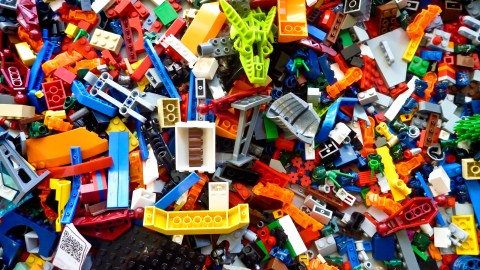1,000 years from now, lego bricks could be found in the ocean

Photo by Rick Mason on Unsplash
- A new study by researchers from the University of Plymouth estimates that it could be up to 1,300 years before LEGO pieces lost to the sea disintegrate.
- Researchers collected fifty LEGO pieces washed up on beaches in southwest England and compared them to archived blocks in their original condition.
- The classic children’s toy is made of an incredibly durable material called acrylonitrile butadiene styrene (ABS), a rock-solid polymer.
Shiploads of tiny LEGO blocks are floating about the Earth’s seas, and a new study estimates that it could be up to 1,300 years before the seemingly imperishable plastic toys disintegrate.
Research findings
In a study published in Environmental Pollution, researchers from the University of Plymouth collected fifty LEGO pieces from beaches in southwest England. The chemicals in the weathered samples were then compared to archived LEGO pieces in their original forms.
“Using measured mass loss of paired (weathered versus unweathered) equivalents and the age of blocks obtained from storage we estimate residence times of between about 100 and 1300 years for this type and thickness of plastic, with variations reflecting differences in precise additive composition and modes of weathering,” the authors write.
How did so many LEGO’s get in the ocean?
So, why are there so many LEGOs at sea anyways? Well, kids, being kids, tend to flush them down the toilet. It’s estimated that 2 million bits of LEGO have been lost to the sewage system. There was also the unfortunate LEGO-spill incident of 1997, when nearly 5 million pieces of the toy fell overboard on a container ship.
Organizations in the United Kingdom like Rame Peninsula Beach Care and the LEGO Lost at Sea Project have done their part to save thousands of the tiny plastic toys from beaches. But if you’ve ever had the experience of stepping on a LEGO brick, you know how sturdy they feel. This new research suggests that their mass and chemical make-up is truly close to indestructible. More likely than not, these blocks will be washing up on shores centuries from now. It’s not entirely clear how these recently discovered LEGOs entered the ocean, but they do match up with toys sold in the 1970s and 80s. And although they have spent decades being weathered, weakened, and yellowed by the sea, researchers were shocked to find them still relatively intact.
“Lego is one of the most popular children’s toys in history and part of its appeal has always been its durability,” said the study’s leader Andrew Turner from the University of Plymouth who studies the chemical properties of marine litter.
“It is specifically designed to be played with and handled, so it may not be especially surprising that despite potentially being in the sea for decades it isn’t significantly worn down. However, the full extent of its durability was even a surprise to us.”

Photo by Daniel Cheung on Unsplash
The indestructible LEGO material
The classic children’s toy is made of an incredibly unsustainable material called acrylonitrile butadiene styrene (ABS), a rock solid polymer. LEGO, which has had to do some greenwashing PR over the years, has pledged to move to more sustainable materials by 2030. But in this case it’s far too little and years too late. ABS is a somewhat new plastic material, and so we can’t be sure what will really happen to them in the far future. But this recent study, and others like it, gives us an unsettling clue. And it is not awesome for sea ecosystems.
“Based on mass difference among paired samples that are about 40 years old we estimate residence times in the marine environment on the order of hundreds of years,” the authors write. They also noted that their findings align with the dissolution expectancy of clear plastic bottles, which have devastated marine life.
“The pieces we tested had smoothed and discolored, with some of the structures having fractured and fragmented, suggesting that as well as pieces remaining intact they might also break down into microplastics,” said Turner.
“It once again emphasizes the importance of people disposing of used items properly to ensure they do not pose potential problems for the environment.”





